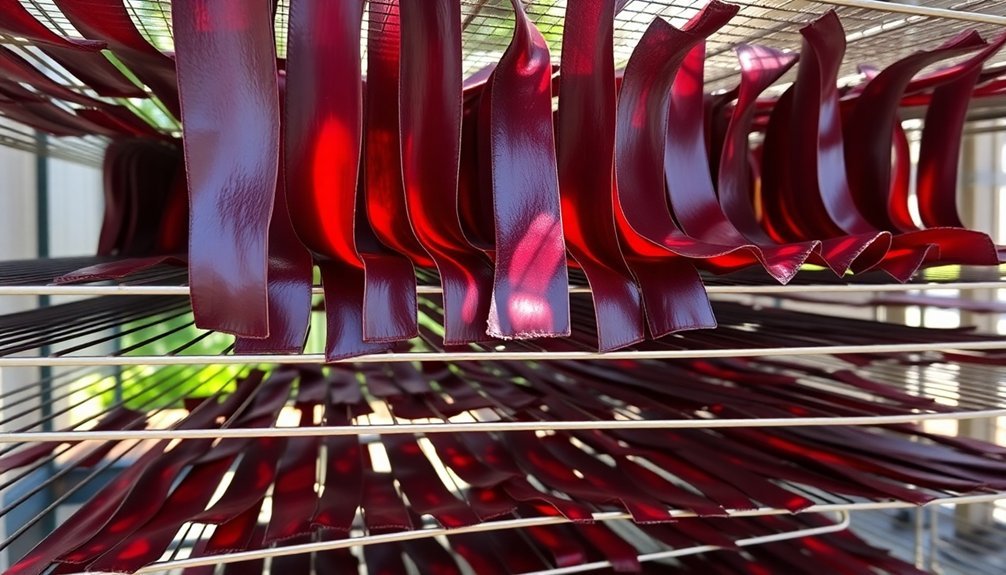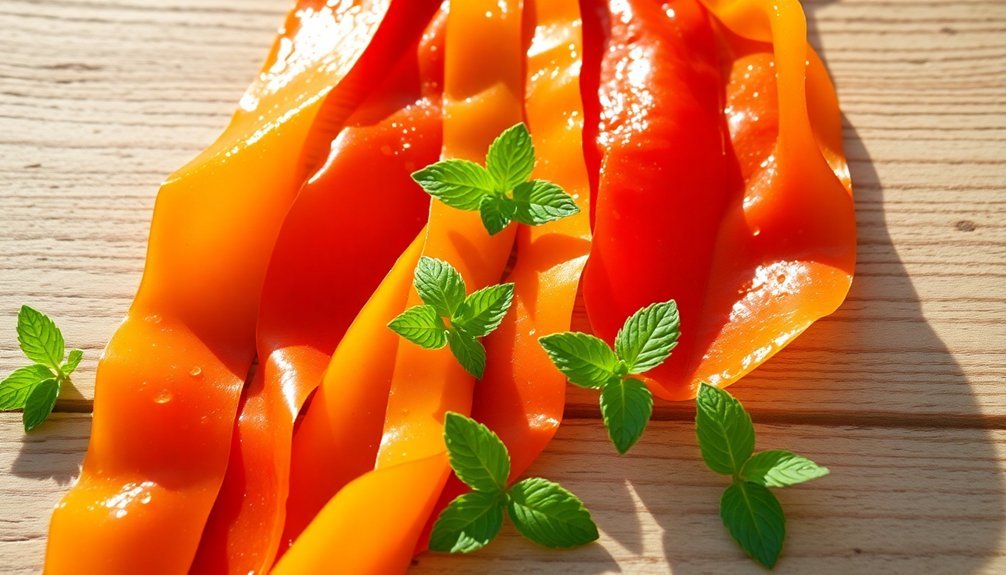To make sun-dried fruit leather, you'll need to follow three key steps. First, prepare your fruit puree by washing and cutting ripe fruits, removing any seeds or cores, then blending until smooth and adding honey or lemon juice for enhanced flavor and preservation. Next, set up your solar drying station in a sunny spot with good airflow, using a wire rack covered with a protective sheet to keep insects away. Finally, spread your puree evenly and let it dry in direct sunlight until no sticky spots remain, then roll and store in airtight containers. These fundamentals will set you on the path to mastering this healthy snack-making technique.
Preparing Perfect Fruit Puree

Creating perfect fruit leather begins with selecting and preparing the right fruit puree. You'll want to choose ripe fruits, including those with minor blemishes that you can easily remove. After washing and sorting your fruit, remove any stems, pits, cores, and seeds. If you're using apples, peaches, or pears, you may need to peel them before proceeding.
Cut your fruit into manageable pieces and puree them using a blender or food mill. If you're working with berries, strain the puree to remove unwanted seeds. You can then process your fruit using either a hot or cold break method to maintain color and prevent scorching. Consider adding salt and spices to create unique flavor combinations.
For juicy fruits, you'll need to concentrate the puree by cooking it over low heat until it thickens. To enhance flavor and preservation, add honey or agave nectar as sweeteners. You can also incorporate lemon juice to maintain color and prevent bacterial growth.
If you're working with low-pectin fruits, combine them with high-pectin varieties like apples for better texture. Remember to adjust your sweetener based on your fruit's natural sugar content, and guarantee your final puree is smooth and even before moving on to the drying process.
Setting Up Solar Drying Station
When choosing a location for your solar drying station, you'll need a spot that receives abundant direct sunlight throughout the day.
Look for an area that's free from shade, especially during peak sun hours, and has good air circulation. Using this method can help prevent post-harvest losses of valuable produce. You'll want temperatures between 100 and 140 degrees Fahrenheit, while avoiding areas prone to rain or high humidity.
Set up your drying surface using a wire baker's rack or door screen that allows proper air flow. You'll need to elevate the drying sheet slightly to prevent the fruit puree from sticking.
Cover your setup with a light protective sheet or screen to keep insects away while allowing moisture to escape.
Consider using specialized equipment like a Chimney Solar Dryer, which traps solar energy and reduces humidity effectively. You can also incorporate transparent covers to maximize sun exposure.
Don't forget to use a hygrometer to monitor water activity levels for safe storage.
Check weather forecasts to confirm you'll have at least 36 hours of sunny conditions.
Monitor your drying progress regularly, keeping the area clean and maintaining proper airflow by clearing any blockages.
Replace damaged covers or sheets as needed to maintain ideal drying conditions.
Drying and Storage Process

The success of fruit leather depends heavily on proper drying and storage techniques.
To begin the drying process, place your covered fruit puree tray in direct sunlight. You'll need to bring it inside each night and return it outdoors the next morning to prevent moisture buildup. The process typically takes a day or longer, and you'll know it's ready when there are no sticky spots or indentations. Using cookie cutters can create fun shapes for kids before storage.
For ideal storage, you must verify your fruit leather is completely dry to prevent mold growth. Once it's ready, roll it tightly using plastic wrap or specialized fruit leather sheets between layers to prevent sticking.
You can store your rolled leather in a food-grade plastic bag, an insect-proof container, or vacuum-sealed bags.
Keep your stored fruit leather in a cool, dark, and dry location. If you're planning for long-term storage, you'll want to think about refrigerating or freezing the leather, which can extend its shelf life beyond one year.
Frequently Asked Questions
How Long Can Homemade Fruit Leather Be Stored Before Going Bad?
You can store your homemade fruit leather for 1-2 months at room temperature, up to 6 months in the refrigerator, or up to 1 year in the freezer when properly sealed in airtight containers.
Can Fruit Leather Be Made During Cloudy or Humid Weather?
You shouldn't make fruit leather during cloudy or humid weather, as it won't dry properly. Instead, use an oven or dehydrator indoors, where you can control temperature and humidity for better results.
What Fruits Should Not Be Used for Making Fruit Leather?
You shouldn't use watermelon, cantaloupe, or other high-water melons alone as they'll create thin, burnt-tasting leather. Also avoid overripe bananas or heavily seeded berries unless you're willing to strain them first.
Are There Food Safety Concerns With Sun-Drying Fruit Leather Outdoors?
Yes, you'll face risks from animal contamination, insects, dust, and bacteria when sun-drying outdoors. You're also more vulnerable to mold growth and foodborne illnesses like Salmonella if proper drying temperatures aren't maintained.
Can Frozen or Canned Fruits Be Used Instead of Fresh Fruits?
Yes, you can use frozen or canned fruits for fruit leather. You'll need to drain canned fruits and blend both types until smooth. They're often more affordable, and you can mix them with fresh fruits too.
In Summary
You've learned the key steps to creating delicious sun-dried fruit leather at home. By carefully preparing your fruit puree, setting up a proper solar drying station, and following the correct drying and storage methods, you'll be able to enjoy homemade fruit leather year-round. Don't forget to check the weather forecast before starting and verify your leather is completely dry before storing.





Leave a Reply